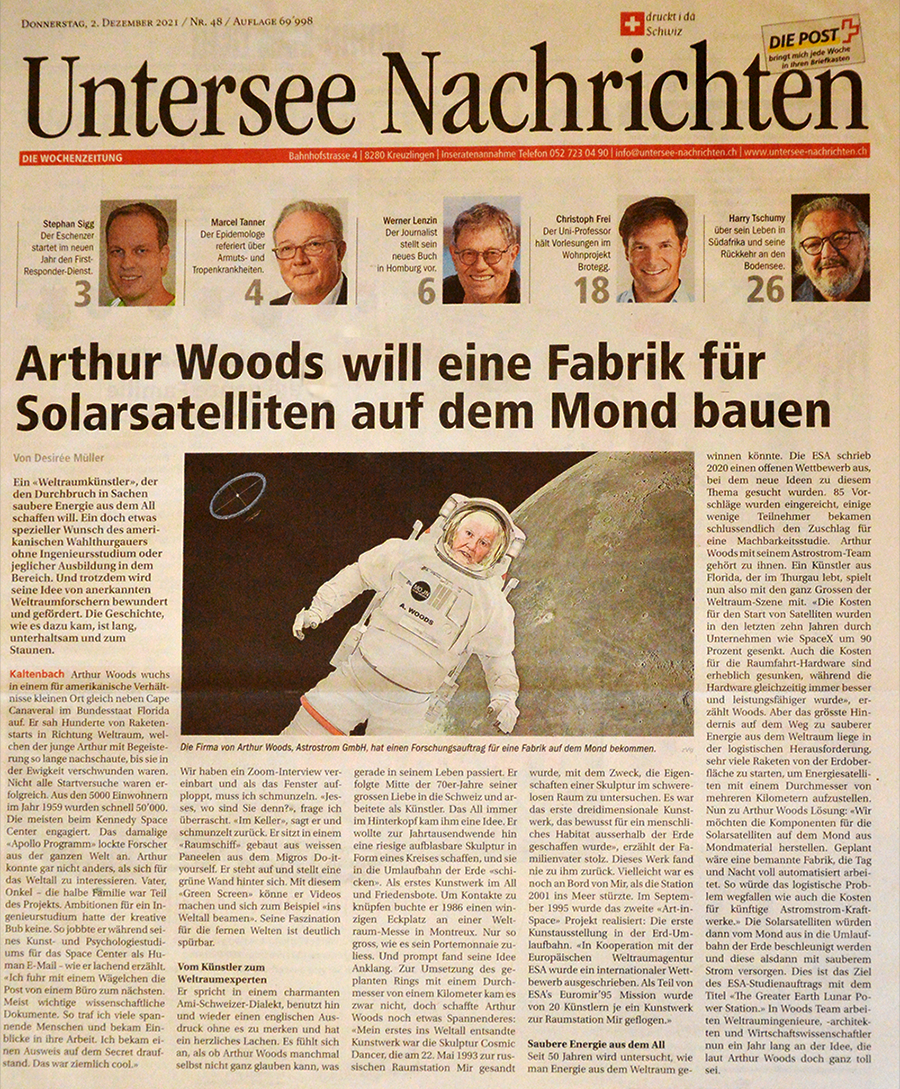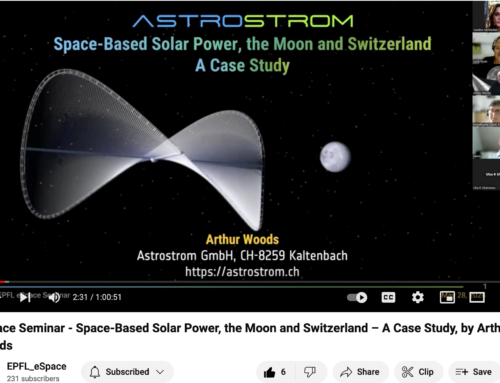English translation:
Arthur Woods wants to Build a Solar Power Satellite Factory on the Moon
A “space artist” who wants to create the breakthrough in clean energy from space – a somewhat special request from Arthur Woods, without an engineering degree or any specific training in the field. And yet, his idea has been recognized by space officials. The story of how it came about is long, entertaining and astonishing.
Desirée Müller
Kaltenbach:
Arthur Woods grew up in a small town by American standards next to Cape Canaveral in the state of Florida. There, he saw hundreds of rocket launches in the direction of space, which young Arthur watched with enthusiasm until they disappeared into infinity. Not all launch attempts were successful.The 5,000 inhabitants in 1959 quickly grew to 50,000. Most of them employed at the Kennedy Space Center. The “Apollo Program” at the time attracted researchers from all over the United States. Arthur couldn’t help but be interested in space. His father, his uncle – half the family were a part of the project. However, the creative young man had no ambitions to study engineering. During his art and psychology studies in the university he worked as ‘human email’ at the space center during the summers – which he laughs about today. “I delivered the mail from one office to the next in a little cart. Mostly important scientific documents. and I met a lot of interesting people and got an insight into their work. I wore an ID with a “Secret” clearance on it. That was pretty cool.”
We have arranged a Zoom interview and when the window popped up I had to smile.”Jesses, where are you?” I asked, surprised. “In the basement,” he says, and smiles back.He is sitting in his “spaceship” made of plastic panels from Migros do-it-yourself. He gets up and puts a green wall behind him. With this “green screen” he makes videos and, for example, “beams himself into space”. His fascination for distant worlds is clearly noticeable.
From Artist to Space Expert
He speaks in a charming Ami-Swiss dialect, uses an English expression every now and then without even realizing it, and has a pleasant smile.It feels like Arthur Woods sometimes can’t quite believe what’s going on in his life right now.
He followed his big love to Switzerland in the mid-1970s and has worked as an artist ever since.With his early space experience in the back of his mind, an idea occurred to him. At the turn of the millennium, he wanted to create a huge inflatable sculpture in the shape of a circle and “send” it into orbit around the Earth – as the first work of art in space in orbit and a messenger of peace.In 1986 he booked a tiny corner only as big as his wallet would allow at a space fair in Montreux to make contacts.And his idea promptly met with approval.
The planned ring with a diameter of one kilometer was not implemented, but Arthur Woods managed something as exciting: «My first work of art sent into space was the sculpture Cosmic Dancer, which was launched to the Russian Mir space station on May 22, 1993, with the purpose of investigating the properties of a sculpture in weightlessness. It was the first three-dimensional work of art that was specifically created for a human habitat outside of Earth, ”says the family man proudly. This work never found its way back to him. Maybe it was still on-board the Mir when the station crashed into the ocean in 2001. In September 1995, his second “Art-in-Space” project was realized: the first art exhibition in Earth orbit. “An international competition was announced in cooperation with the European Space Agency as part of ESA’s Euromir’95 mission. 20 artists each sent 1 work of art to the Mir space station.”
Clean Energy from Space
For over fifty years, research has been carried out into how to obtain energy from space. In 2020, ESA announced an open competition for new ideas on this topic. 85 proposals were submitted, and a few participants were ultimately awarded contracts to do feasibility studies. Arthur Woods with his Astrostrom team is one of them. So an artist from Florida is now playing with the greats in the space scene. “The cost of launching satellites has been reduced by 90 percent over the past decade by companies like SpaceX. The cost of the space hardware has also fallen significantly, while the hardware has become better and more powerful at the same time, ”explains Woods. But the biggest obstacle on the way to clean energy from space lies in the logistical challenge, to launch a large number of rockets from the surface of the Earth in order to deploy power satellites with a diameter of several kilometers in orbit. Arthur Woods’ solution: “We want to manufacture the components for the solar power satellites on the Moon from lunar materials. The plan is to have a factory with a small human crew that works fully automatically day and night. This would eliminate the logistical problem as well as the costs for future Astrostrom power plants. ” The solar power satellite components would then be assembled in lunar orbit and then sent to Earth and supply it with clean electrical power. This is the aim of the ESA study contract entitled “The Greater Earth Lunar Power Station.” In Woods’ team, space engineers, architects and economists will be working on the idea for one year which, according to Arthur Woods, “is really great”.
Untersee Nachrichten, Kreuzlinger Nachrichten, Frauenfelder Nachrichten, Weinfelder Nachrichten
Desirée Müller / Distribution 70,000 (Canton Thurgau)
December 2, 2021
Original version in German:
Arthur Woods will eine Fabrik für Solarsatelliten auf den Mond bauen
Ein «Weltraumkünstler», der den Durchbruch in Sachen grüne Energie aus dem All schaffen will. Ein doch etwas spezieller Wunsch von Arthur Woods ohne Ingenieursstudium oder jeglicher Ausbildung in dem Bereich. Und trotzdem wird seine Idee von anerkannten Weltraumforschern bewundert und gefördert. Die Geschichte, wie es dazu kam, ist lang, unterhaltsam und zum Staunen.
Desirée Müller
Kaltenbach:
Arthur Woods wuchs in einem für amerikanische Verhältnisse kleinen Ort gleich neben Cape Canaveral im Bundesstaat Florida auf. Er sah Hunderte von Raketenstarts in Richtung Weltraum, welchen der junge Arthur mit Begeisterung so lange nachschaute, bis sie in der Ewigkeit verschwunden waren. Nicht alle Startversuche waren erfolgreich. Aus den 5000 Einwohnern im Jahr 1959 wurden schnell 50’000. Die meisten beim Kennedy Space Center engagiert. Das damalige «Apollo Programm» lockte Forscher aus der ganzen Welt an. Arthur konnte gar nicht anders, als sich für das Weltall zu interessieren. Vater, Onkel – die halbe Familie war Teil des Projekts. Ambitionen für ein Ingenieursstudium hatte der kreative Bub aber keine. So jobbte er während seines Kunst- und Psychologiestudiums für das Space Centers als Human E-Mail – wie er heute lachend erzählt. «Ich fuhr mit einem Wägelchen die Post von einem Büro zum nächsten. Meist wichtige wissenschaftliche Dokumente. So traf ich viele spannende Menschen und bekam einen Einblick in deren Arbeit. Ich bekam einen Ausweis auf dem Secret draufstand. Das war schon ziemlich cool.» Wir haben ein Zoom-Interview vereinbart und als das Fenster aufploppt muss ich schmunzeln. «Jesses, wo sind Sie denn?», frage ich überrascht. «Im Keller», sagt er und schmunzelt zurück. Er sitzt in einem «Raumschiff» gebaut aus weissen Paneelen aus dem Migros Do-it-yourself. Er steht auf und stellt eine grüne Wand hinter sich. Mit dieser «Green Screen» könne er Videos machen und sich zum Beispiel «ins Weltall beamen». Seine Faszination für die fernen Welten ist deutlich spürbar.
Vom Künstler zum Weltraumexperten
Er spricht in einem charmanten Ami-Schweizer-Dialekt, benutzt hin und wieder einen Englischen Ausdruck ohne es zu merken und hat ein herzliches Lachen. Es fühlt sich an, als ob Arthur Woods manchmal selbst nicht ganz glauben kann, was gerade in seinem Leben passiert. Er folgte Mitte der 70er-Jahre seiner grossen Liebe in die Schweiz und arbeitete als Künstler. Das All immer im Hinterkopf kam ihm eine Idee. Er wollte zur Jahrtausendwende hin eine riesige aufblasbare Skulptur in Form eines Kreises schaffen, und sie in die Umlaufbahn der Erde «schicken». Als erstes Kunstwerk im All und Friedensbote. Um Kontakte zu knüpfen buchte er 1986 einen winzigen Eckplatz an einer Weltraum-Messe in Montreux. Nur so gross, wie es sein Portemonnaie zuliess. Und prompt fand seine Idee Anklang. Zur Umsetzung des geplanten Rings mit einem Durchmesser von einem Kilometer kam es zwar nicht, doch schaffte Arthur Woods noch etwas Spannenderes: «Mein erstes ins Weltall entsandte Kunstwerk war die Skulptur Cosmic Dancer, die am 22. Mai 1993 zur russischen Raumstation Mir gesandt wurde, mit dem Zweck, die Eigenschaften einer Skulptur im schwerelosen Raum zu untersuchen. Es war das erste dreidimensionale Kunstwerk, das bewusst für ein menschliches Habitat ausserhalb der Erde geschaffen wurde», erzählt der Familienvater stolz. Dieses Werk fand nie zu ihm zurück. Vielleicht war es noch an Bord von Mir, als die Station 2001 in Meer stürzte. Im September 1995 wurde das zweite «Art-in-Space» Projekt realisiert: Die erste Kunstausstellung in der Erd-Umlaufbahn. «In Kooperation mit der Europäischen Weltraumagentur ESA wurde ein internationaler Wettbewerb ausgeschrieben. Als Teil von ESA’s Euromir’95 Mission wurde von 20 Künstlern je 1 Kunstwerk zur Raumstation Mir geflogen.»
Saubere Energie aus dem All
Seit fünfzig Jahren wird untersucht, wie man Energie aus dem Weltraum gewinnen könnte. Die ESA schrieb 2020 einen offenen Wettbewerb aus, bei dem neue Ideen zu diesem Thema gesucht wurden. 85 Vorschläge wurden eingereicht, einige wenige Teilnehmer bekamen schlussendlich den Zuschlag für eine Machbarkeitsstudie. Arthur Woods mit seinem Astrostrom-Team gehört zu ihnen. Ein Künstler aus Florida spielt nun also mit den ganz Grossen der Weltraum-Szene mit. «Die Kosten für den Start von Satelliten wurden in den letzten zehn Jahren durch Unternehmen wie SpaceX um 90 Prozent gesenkt. Auch die Kosten für die Raumfahrt-Hardware sind erheblich gesunken, während die Hardware gleichzeitig immer besser und leistungsfähiger wurde», erzählt Woods. Aber das grösste Hindernis auf dem Weg zu sauberer Energie aus dem Weltraum liege in der logistischen Herausforderung, sehr viele Raketen von der Erdoberfläche zu starten, um Energiesatelliten mit einem Durchmesser von mehreren Kilometern aufzustellen. Nun zu Arthur Woods Lösung: «Wir möchten die Komponenten für die Solarsatelliten auf dem Mond aus Mondmaterial herstellen. Geplant wäre eine bemannte Fabrik, die Tag und Nacht voll automatisiert arbeitet. So würde das logistische Problem wegfallen wie auch die Kosten für künftige Astromstrom-Kraftwerke.» Die Solarsatelliten würden dann vom Mond aus in die Umlaufbahn der Erde beschleunigt werden und diese alsdann mit sauberen Strom versorgen. Dies ist das Ziel des ESA-Studienauftrags mit dem Titel «The Greater Earth Lunar Power Station.» In Woods Team arbeiten Weltraumingenieure, -architekten und Wirtschaftswissenschaftler nun ein Jahr lang an der Idee, die laut Arthur Woods doch ganz toll sei.
Untersee Nachrichten, Kreuzlinger Nachrichten, Frauenfelder Nachrichten, Weinfelder Nachrichten
Desirée Müller / Distribution 70,000 (Kanton Thurgau)
2. Dezember 2021






